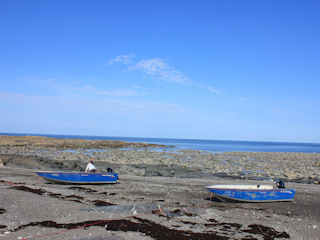 Paul Ostiguy and his staffs most difficult hurdle at Inukshuk Lodge is dealing with tides. Ungava Bay is the Atlantic Ocean and in this particular location the variation from low tide to high tide is one of the largest in the world. Its two days after the new moon (spring tide) and todays difference between low tide and high tide was a remarkable 42 feet.
Paul Ostiguy and his staffs most difficult hurdle at Inukshuk Lodge is dealing with tides. Ungava Bay is the Atlantic Ocean and in this particular location the variation from low tide to high tide is one of the largest in the world. Its two days after the new moon (spring tide) and todays difference between low tide and high tide was a remarkable 42 feet.
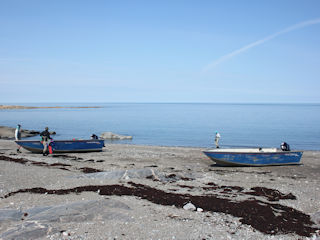 Due to the rocks and a quarter mile of dry land at low tide, we can only leave and return in our fishing boats within two hours of the high tide – either before or after. This makes for either a very short four-hour fishing day or a long one of going out and staying out for twelve hours until the next high tide returns. Today, where high tide was at 10 AM and 11 PM, and the weather was good, we were able to take the long-day route leaving at 8:30 AM and returning at 9 PM.
Due to the rocks and a quarter mile of dry land at low tide, we can only leave and return in our fishing boats within two hours of the high tide – either before or after. This makes for either a very short four-hour fishing day or a long one of going out and staying out for twelve hours until the next high tide returns. Today, where high tide was at 10 AM and 11 PM, and the weather was good, we were able to take the long-day route leaving at 8:30 AM and returning at 9 PM.
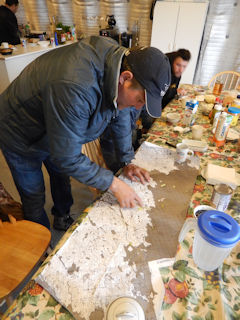 Paul can’t count on being able to do full days safely forever. If the weather were to turn (and up here I suspect it can in a heartbeat) we could be trapped at sea unable to beach at the lodge. In the next week Paul and the guides will learn the art to mooring the boats from Jonny May and his Inuit neighbors on Black Rock Point. It may sound easy if you’ve moored a boat on a freshwater lake, but remember, today had a 42-foot water depth swing with the tides. In Ungava Bay, mooring a boat is taming the ocean. You better know what you’re doing.
Paul can’t count on being able to do full days safely forever. If the weather were to turn (and up here I suspect it can in a heartbeat) we could be trapped at sea unable to beach at the lodge. In the next week Paul and the guides will learn the art to mooring the boats from Jonny May and his Inuit neighbors on Black Rock Point. It may sound easy if you’ve moored a boat on a freshwater lake, but remember, today had a 42-foot water depth swing with the tides. In Ungava Bay, mooring a boat is taming the ocean. You better know what you’re doing.
To make today more interesting, the waters here are completely new to Paul and his guides Burt and Simon. Yes, we snuck out last night. And yes, Paul came here on a short trip last summer when purchasing this lodge, but all in all, the next few days is a 100% exploration mission (we do have GPS).
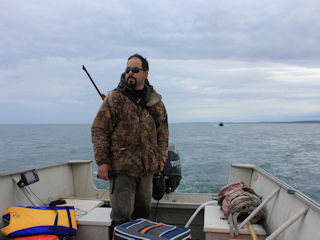 Furthermore, Burt is the only one of all of us that’s run a boat on cold water oceans before. Simon, Paul and I know boats but the nature of the Arctic seas is dangerous. Start with the water temperatures that range from 38° – 44°F. If you fall in you have two minutes to live. And with the huge tides, areas that are safe to navigate at high tide could expose deadly rocks at low tide. Last, these enormous tides create roaring current seams like you can find whitewater rafting. The word “Exploratory trip” gets tossed around a lot these days. I think this one qualifies.
Furthermore, Burt is the only one of all of us that’s run a boat on cold water oceans before. Simon, Paul and I know boats but the nature of the Arctic seas is dangerous. Start with the water temperatures that range from 38° – 44°F. If you fall in you have two minutes to live. And with the huge tides, areas that are safe to navigate at high tide could expose deadly rocks at low tide. Last, these enormous tides create roaring current seams like you can find whitewater rafting. The word “Exploratory trip” gets tossed around a lot these days. I think this one qualifies.
 So off we went this morning. Paul and I rode with Burt and led the way while Simon drove the other boat with the Wildcats Fly Fishing guys, Jerome and David (they are filming a TV show this week). As you can imagine we took it slow and headed to a place Johnny pointed out on the map called Ely Island. We were cautiously excited.
So off we went this morning. Paul and I rode with Burt and led the way while Simon drove the other boat with the Wildcats Fly Fishing guys, Jerome and David (they are filming a TV show this week). As you can imagine we took it slow and headed to a place Johnny pointed out on the map called Ely Island. We were cautiously excited.

Ely Island is only about three miles from camp and with the calm seas took less than ten minutes. When we arrived none of us could believe our eyes. A polar bear was sleeping on the highest rock!
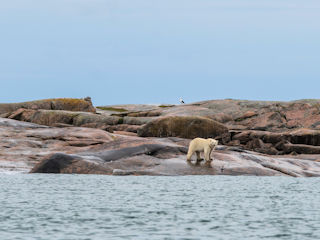
At first the bear opened his eyes. I could see them open black as coal. Then he lifted his head. Once he knew for sure something was up he stood and came right down to the water’s edge. I thought he was going to make a swim our way but luckily he didn’t. Instead he grabbed a seat like a giant Labrador retriever and stared and smelled trying to catch our scent.
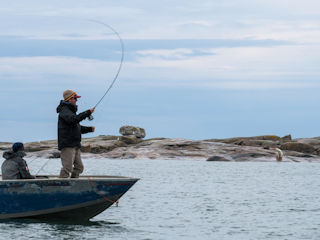
This polar bear experience was much more pleasurable than yesterdays. After we enjoyed the white bear for about ten minutes it was evident he wasn’t ready to get his paws wet. We were in what looked like pretty good fishing water so I went to work. It’s not often you get to cast in front of a polar bear!
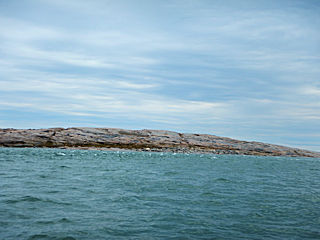 The water looked excellent. There were rocks surrounded by deep water and current lines against shore. I don’t know much about fly fishing for Arctic char but in my mind this was a good place. But after fishing around Ely Island for more than an hour at every good-looking spot without a tug we began to scratch our heads. What is the ideal char water?
The water looked excellent. There were rocks surrounded by deep water and current lines against shore. I don’t know much about fly fishing for Arctic char but in my mind this was a good place. But after fishing around Ely Island for more than an hour at every good-looking spot without a tug we began to scratch our heads. What is the ideal char water?
The question “What is the ideal char water?” gets much more confusing when you think about it. When you have 40 feet plus tide changes means the fish move constantly. And what about baitfish? What flies should we use? All we could do is keep trying and our next move was to move. The weather was great so we boated to the next set of islands called Bird Island and Duck Island.
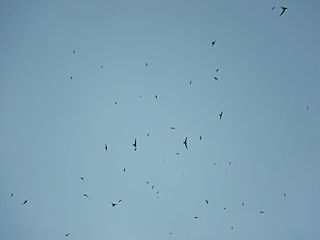 It was another 20 minutes or so to these islands and they’re rightfully named after birds. We saw hundreds of Arctic terns, sea pigeons and eider and scoter ducks. There’s and amazing amount of seabird life. And we couldn’t help but notice that nearly every tern and sea pigeon had a sand lance in its mouth (looks like a baby American eel but they aren’t). The char had to be here.
It was another 20 minutes or so to these islands and they’re rightfully named after birds. We saw hundreds of Arctic terns, sea pigeons and eider and scoter ducks. There’s and amazing amount of seabird life. And we couldn’t help but notice that nearly every tern and sea pigeon had a sand lance in its mouth (looks like a baby American eel but they aren’t). The char had to be here.
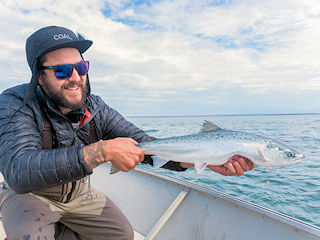
Burt held the boat like a champ while Paul and I cast streamers to the rocks and down current seams. Paul actually fished sand lance fly patterns. Our GPS also has fish finding sonar and Burt saw huge bait balls of sand lances but we couldn’t touch a fish. It was so slow that the other guys decided to troll flies. Lo and behold, Jerome locked into this small Atlantic salmon.
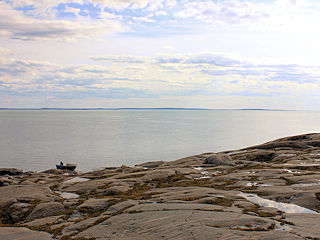 Four hours of fishing without a bite then Jerome trolls up a salmon and the confidence level sky rockets. I cranked my chucking and ducking up a notch but another couple hours went by with nothing and soon it was low tide. We’d been in the boat all day so Burt pulled us up on Bird Island for a break.
Four hours of fishing without a bite then Jerome trolls up a salmon and the confidence level sky rockets. I cranked my chucking and ducking up a notch but another couple hours went by with nothing and soon it was low tide. We’d been in the boat all day so Burt pulled us up on Bird Island for a break.
We didn’t park on Bird Island until we circumnavigated it carefully scanning for polar bears. Meeting a starved polar bear on foot would really suck. Once on foot Paul and Burt went collecting mussels for dinner while I headed to a distant point. I was weary on my walk hoping not to wake up a polar bear we didn’t see.
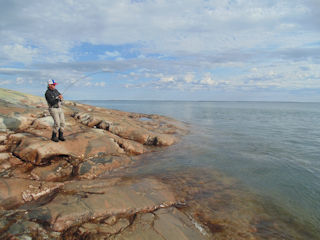 The point looked good. I had my Winston 7-weight with my SA Sonar Sink 25 Cold 250 gr and my usual two fly rig for streamer fishing. There was good current from the tide starting to rise. I had a feeling and sure enough I caught my first Arctic char of the trip.
The point looked good. I had my Winston 7-weight with my SA Sonar Sink 25 Cold 250 gr and my usual two fly rig for streamer fishing. There was good current from the tide starting to rise. I had a feeling and sure enough I caught my first Arctic char of the trip.
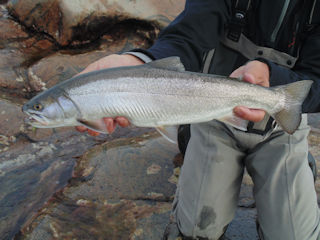 Once I wipe the skunk off I usually start catching fish. It wasn’t five more casts and I got another fish. I knew right away this was a smaller one but it put up a great fight. Turns out it was my first ever sea run brook trout. It was the silveriest brookie I’ve ever seen but you could tell he was a brookie by his fins and upon very close observation you could see a few tiny tiny red dots. Fantastic!
Once I wipe the skunk off I usually start catching fish. It wasn’t five more casts and I got another fish. I knew right away this was a smaller one but it put up a great fight. Turns out it was my first ever sea run brook trout. It was the silveriest brookie I’ve ever seen but you could tell he was a brookie by his fins and upon very close observation you could see a few tiny tiny red dots. Fantastic!
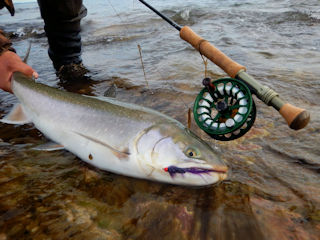 The fish gates opened right then. Burt and Paul came over for a piece of the action and we radioed the other guys to park the boat and join us. But despite all the lines in the water along this point I was the only one hooking up. Most of my luck was on this purple egg sucking bugger. I landed three more char including a handsome fish of about 7lbs.
The fish gates opened right then. Burt and Paul came over for a piece of the action and we radioed the other guys to park the boat and join us. But despite all the lines in the water along this point I was the only one hooking up. Most of my luck was on this purple egg sucking bugger. I landed three more char including a handsome fish of about 7lbs.
 When tides change you have what is referred to as the slack. The water and currents don’t move much. Then they gradually start to move and during the first hour it’s hard to notice. Here it’s the same but after that first hour the change becomes drastic. Three hours into the rising tide, the water comes up over an inch a minute. Think about that. . . . 15 minutes after I landed my last char from this point the point was gone underwater and we had to retreat to our boats and move.
When tides change you have what is referred to as the slack. The water and currents don’t move much. Then they gradually start to move and during the first hour it’s hard to notice. Here it’s the same but after that first hour the change becomes drastic. Three hours into the rising tide, the water comes up over an inch a minute. Think about that. . . . 15 minutes after I landed my last char from this point the point was gone underwater and we had to retreat to our boats and move.
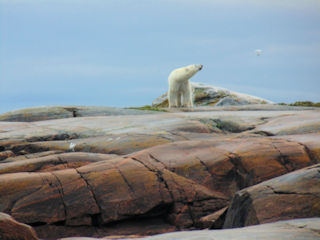 We moved in the way of back to camp with a return to Ely Island. Indeed, we checked on our polar bear and he was there. Once again he woke from a nap and waddled down to the water’s edge and sat down to watch and smell the air. The water was much lower than when we were here this morning and there were new spots to try. I released a small char while in a quick drift so we headed back up to try the drift again.
We moved in the way of back to camp with a return to Ely Island. Indeed, we checked on our polar bear and he was there. Once again he woke from a nap and waddled down to the water’s edge and sat down to watch and smell the air. The water was much lower than when we were here this morning and there were new spots to try. I released a small char while in a quick drift so we headed back up to try the drift again.
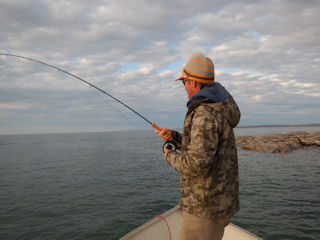
As most of you know, when it comes to tossing streamers I rarely fish less than two and I already mentioned today was no exception. I had on my purple egg sucking bugger as my dropper and a flashy weird thing on my point. Paul moved a nice fish on a Pixee lure but he wouldn’t eat it. As the fish gave up on Paul’s spoon I laid my fly the direction of the fish and hooked him quick. He was a big dog and took off.
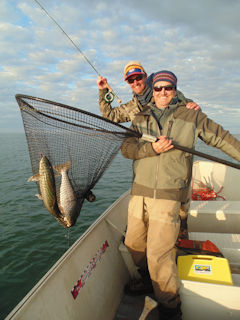 The fight of this Arctic char was impressive. I was fishing the same 7-weight I landed the permit on a few weeks ago and this fish had my green rod bent deep. Three minutes into battle I had full control and hoisted the fish towards the boat. But not so fast. Suddenly the fight increased again only it felt unexplainably weird. I suspected two fish and I was right!
The fight of this Arctic char was impressive. I was fishing the same 7-weight I landed the permit on a few weeks ago and this fish had my green rod bent deep. Three minutes into battle I had full control and hoisted the fish towards the boat. But not so fast. Suddenly the fight increased again only it felt unexplainably weird. I suspected two fish and I was right!
When I said I had two char Burt and Paul gave me that look – if looks could kill. Paul knows me pretty well and perhaps he thought I was joking. Burt took no chances and pulled out his camera and started the video. Soon I was explaining to Paul how to net two fish. Normally netting two fish is a difficult chore. Paul nailed them both on the first try.
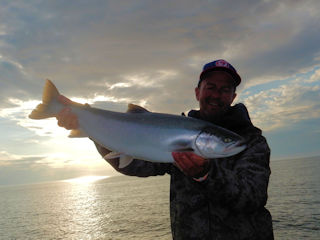 These two Arctic char were nice ones. One was about 8lbs and the other around 6lbs. They compiled the best double I’ve ever landed. Fun stuff! What a day!
These two Arctic char were nice ones. One was about 8lbs and the other around 6lbs. They compiled the best double I’ve ever landed. Fun stuff! What a day!
At an inch a minute, after two more hours of fishing the tide was so high we knew we could return to Inukshuk Lodge for the day. We were haggard. We fished hard for 12 straight hours mostly from a rocking boat in cold conditions. We all cherished every minute of it but it was dinner time.
 We returned with an amazing Arctic sunset to the northwest of us around 9 PM. Fred and Ludo were there with the tractor to pull the boats up high for the night. We told them of the second polar bear and they were glad to hear there are more out there and that this one is in a safer place. Hopefully he has a long life and makes his way back north this winter.
We returned with an amazing Arctic sunset to the northwest of us around 9 PM. Fred and Ludo were there with the tractor to pull the boats up high for the night. We told them of the second polar bear and they were glad to hear there are more out there and that this one is in a safer place. Hopefully he has a long life and makes his way back north this winter.
Tomorrow we’ll do our best to squeeze in another long day. This place is insane! Stay tuned. . . .
A special thanks to my friend Paul Ostiguy the proud owner of McKenzie River Lodge in Labrador and Inukshuk Lodge in Nunavik.
